Direct from BOOM Finance and Economics at the links below
Hat Tip to my colleague at BOOM Fin4ance and Economics Substack (Subscribe for Free) – also on LinkedIn and WordPress. Covid Medical News Network CMN News BOOM Blog and All Editorials (over 5 years) at BOOM Finance and Economics | Designed for Critical Thinkers — UPDATED WEEKLY (WordPress.com)
BOOM Finance and Economics seeks out the very best information from authoritative sources and strives for consistency in its quality and trustworthiness. Over 5 years, BOOM has developed a loyal readership which includes many of the world’s most senior economists, central bankers, their senior advisers, fund managers, and academics. If you want a real edge in understanding the complex world of finance and economics, subscribe to BOOM on Substack or as a Follower on LinkedIn.
BOOM EDITORIAL THIS WEEK
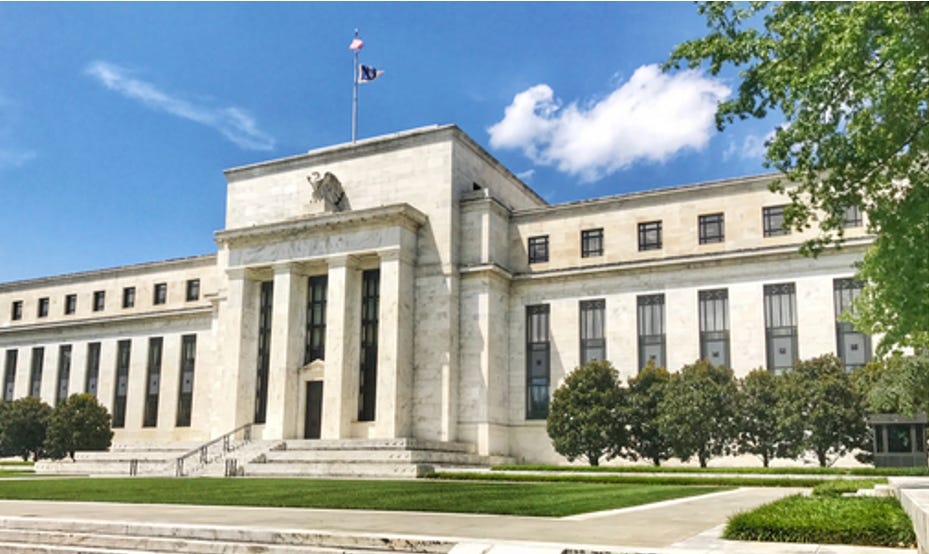
The confusion springs from a misunderstanding of language. Three words are the cause: debt, borrow, and print. Most people assume that they understand these words, but that assumption is false when it comes to government finances.
Misunderstanding “debt” confuses. The word “borrow” is also inappropriate to use when discussing Federal Government finances. And the word “print” is often used inappropriately regarding money supply. No wonder there is confusion.
The fact is that Federal Governments do not borrow money (generally, in most circumstances), and in advanced economies, they print only 2% of the money supply (as notes and coins). That sounds ridiculous but it’s true.
To fund their budget deficits, national governments sell contractual securities issued by their Treasury department (usually called Treasury Bonds). The bonds are investment contracts, offered to willing investors, for a defined period, at a defined rate of return, and which expire at the Maturity Date, fixed within the contract terms. The funds governments receive from investors are used in their expenditure programs as they finance their budget deficits.
Governments are not “in massive debt” that has enslaved them. They have sold securities and received funds. They (almost always) repay the investors at the Maturity Date. Defaults by governments on such contractual agreements are rare. Governments are NOT “borrowing large amounts of unpayable debt” and they are NOT “printing massive amounts of new money”.
Our children and grandchildren will not be “enslaved by government debt”. Almost ALL of the money used by Bond investors, when they purchase Government Bonds, is old money created (originated) some time ago in a bank loan contract. It may have originated in a home loan contract 20 years ago. That old money, received by the Treasury Department from investors, is re-circulated (spent) into the real economy by governments as part of their expenditure programs.
In other words, NO NEW MONEY is created when a Government funds its deficit spending program, with one exception. That is when a central bank runs a Quantitative Easing Program (QE) which, believe it or not, is a relatively rare event.
One more thing is important to note. Governments (in almost all cases) do not apply to banks for bank loans. Unlike bank loans, Bonds are not collateralised. This is an important point. No collateral is offered by the government to investors as security.
QE EXPLAINED: Quantitative Easing Programs (QE) in plain language that anyone can understand, QE is a rarely used form of monetary policy in which a central bank purchases securities (such as government bonds or other securities) from the Treasury or on the open market to reduce interest rates and increase the money supply in the real economy.
The effect is to raise CPI inflation in the real economy (where goods and services are transacted). It also tends to cause Asset Price inflation but that discussion is for another day.
After the purchase is completed, the central bank holds the bonds. And the funds used for settlement flow to the Treasury. The Government then spends those funds as per usual according to its budgetary requirements. These funds are over and above the funds raised by the government from taxation.
To fund those Bond purchases, the central bank creates new bank reserves inside the banking system which can also be used to provide banks with more liquidity, encouraging lending and investment. This graph shows the balance sheet of the US central bank (the Federal Reserve) since the Global Financial Crisis in 2008. The QE effects are obvious.
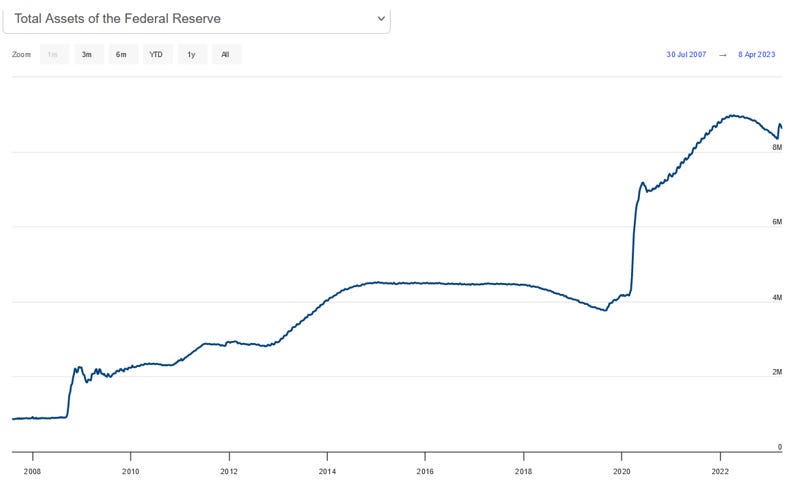
The sum is calculated thus: $8tn – $290tn x100 = 2.75%. That is NOT “massive amounts of fresh new ‘printed’ money”. Some critics say that the Fed should not have done this but the alternative would have been to collapse the entire banking sector of the United States (which, by the way, had been precariously weakened by rampant fraud in the US commercial and investment banking sector). The choice was stark but, in reality, the central bank decided to bail out the economy and the banking system and the outcome was predictable.
The result was that not many fraudulent bankers or brokers were sent to jail for fraud. But that is another matter altogether. It is another discussion for another day.
JAPAN IS A WORLD CHAMPION FOR GOVERNMENT “DEBT” ISSUANCE. Last week, BOOM claimed the Japanese Government to be the world champion of Government “debt”. It has a gross debt-to-GDP ratio of 264%. This is much higher than all other nations. The United States ratio is about 115%, less than half that, and Switzerland is a mere 34% with Australia’s at about 45%.
Japan’s huge government debt-to-GDP ratio of 264% sounds horrendous, doesn’t it? And their central bank’s Balance Sheet also looks dramatically scary.
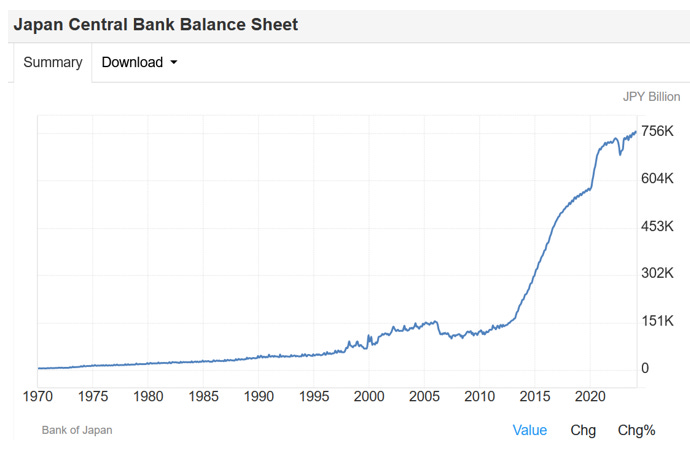
This chart is the US Dollar versus the Japanese yen since 2007. The yen has fallen against the US Dollar over the last three years (the USD is rising) but that only means it is simply moving back towards levels last seen in the 1980’s. No need to panic.
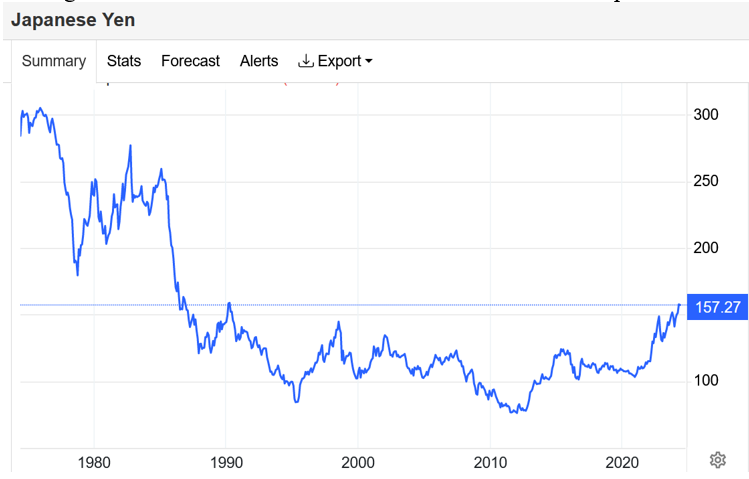
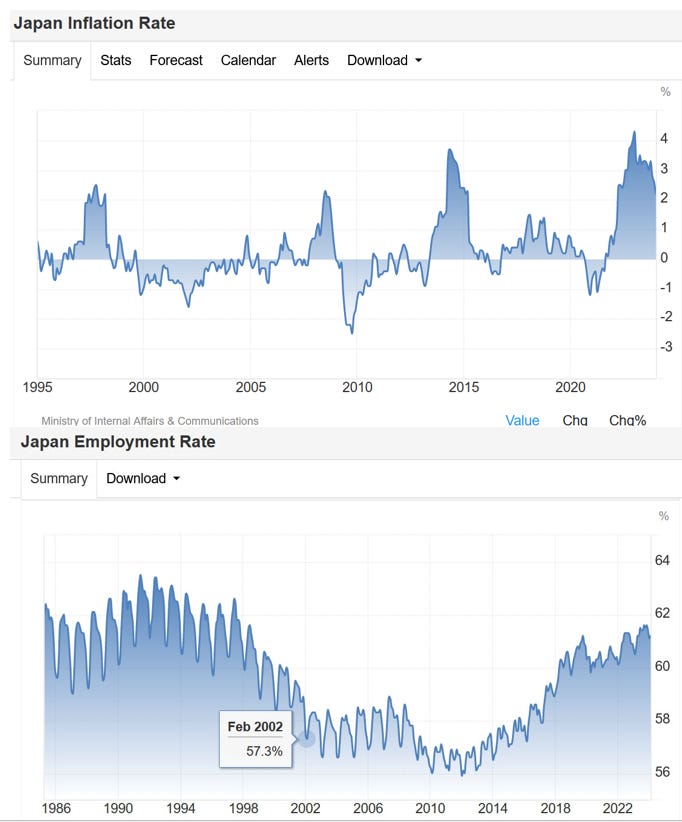
GOVERNMENT DEBT-to-GDP RATIOS ARE FALLACIOUS. For a better perspective, BOOM says that Government “Debt-to-GDP Ratios” is a false representation. They compare 20 years of “debt” (Bond issuance) to just one year of GDP. This is disingenuous.
BOOM prefers to express the ratio as 20 years of government “debt” to 20 years of GDP. That would make more sense. As of March 2023, the Japanese public debt is estimated to be US$9.2tn (1.30 quadrillion yen), or 264% of GDP, and is the highest in developed nations (by far). 43.3% of that “debt” is held by the Bank of Japan (the central bank). Over the last 20 years, Japan’s GDP has averaged about US$5tn/year. Thus, 20 years of GDP is roughly equivalent to $100tn.
Dividing $9.2tn “debt” by $100tn GDP (instead of $5tn), the Debt-to-GDP ratio falls from 264% to 9.2%. And, if we subtract the “debt” owned by the central bank, it falls to 5.2%. A debt-to-GDP ratio of 5.2% does not sound so bad and Japan is the World Champion of government debt. All other governments have “debt” ratios far below that figure. Maybe not to panic about Government “debt” then? Almost no new money is created to fund it. It is not borrowed from banks in a bank loan. The nation is not offered as collateral. It is not the cause of “horrendous” CPI inflation or terrible unemployment. Our children and grandchildren will not be “forced to pay it off”. And the nation will not “go bankrupt”. Private debt is another matter but again for discussion another day.
COMMUNIST USSR VERSUS COMMUNIST CHINA. The long-term outcomes between these two communist systems have been very different. BOOM thinks it all boils down to three key factors.
After 70 years of Marxist, communist government, the USSR (the Union of Soviet Socialist Republics) famously collapsed in 1991 both economically and politically.
Communist China has existed since 1949 which is now well over 70 years. However, the People’s Republic of China currently appears to be very strong in both political and economic terms. How can this difference be explained?
The outcomes of the two communist systems are strikingly different because the two systems of communism are strikingly different. There are reasons for this disparity of outcome. BOOM explains the differences in outcome as being attributed to three key variables:
- Management of the banking/financial system
- Productivity (or lack of it) in the respective real economies (where goods and services are transacted).
- Ownership of private property.
Private property was rapidly and progressively confiscated by the communist State in the USSR. When the USSR was dissolved in 1991, only 0.09% of residences in the USSR were privately owned.
In China, the Constitution was altered in 1970 to allow the private ownership of rights to property. That was strengthened in 1982 with the Property Law.
The USSR leadership was ideology-driven. The working class struggle as described by Marx was their inspiration. Unfortunately, Marx did not give a good platform for understanding either money supply management, productivity, or property ownership. In the USSR, following Marxist principles, banned private ownership of almost all property, made many mistakes in money supply and distribution, and did not reward productivity. These three failings led to the ultimate and predictable collapse of the USSR economy.
WARNING FOR THE WEST. Ominously, the Western advanced economies are now beginning to show signs of failure in all three parameters above. These nations don’t understand how to generate good, strong management of their financial and banking sectors with effective control of both money supply volume and cost.
This task has been outsourced to central banks and is potentially compromised in a weak position (variously described as being “independent”). The bankers do not focus on productivity and private property is progressively compressing into fewer and fewer owners Many citizens are left homeless or destined to rent for the rest of their lives. Economic failure is inevitable if the three parameters above are not addressed as proven by the USSR.
MARXIST MISTAKES
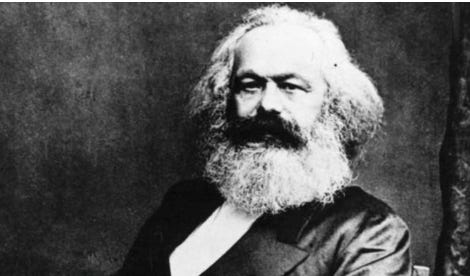
Distribution of the money supply was also a constant problem without a system of private, commercial banks spread geographically throughout the vast expanses of the USSR empire. All of this led to instability in economic expectations resulting in a disastrous lack of productivity in the real economy. This was summarised by the famous Russian joke phrase “We pretend to work and they pretend to pay us”. And, to make matters worse, private property was progressively confiscated.
The Chinese have not made these mistakes. They manage their money supply rigorously and with great discipline as an essential part of the economy. They drive fresh new money, created as new bank loans, into the economy where and when needed. This means that the economy does not wait for willing borrowers to raise fresh new credit money into existence.
Central command decides when fresh new credit money, created by the commercial banks in bank loans, is directed towards meeting the needs of the real economy. Once that money is allocated, the real economy is focused on productivity creating useful goods and services. Thus, increasing productivity is assured.
And, last but not least, private ownership of property (residences and businesses) is encouraged. The Property Law introduced in 2007 protects the interest of private investors to the same extent as that of national interests. Ownership rights are protected under Article 39 of The Property Law of the People’s Republic of China, which gives the owner the right to possess, utilise, dispose of, and obtain profits from the real property.
However, this right has to comply with laws and social morality. It can harm neither public interests nor the legitimate rights and interests of others. Foreign investors are not allowed to buy land in China. The land in China always belongs to the State and the collectives.
Real property rights in China can generally be grouped into three types: ownership rights, usufructuary rights, and security rights. Usufruct is a limited real right that unites the two property interests of usus and fructus:
- Usus (use, as in the usage of or access to) and is the right to use or enjoy a thing possessed, directly and without altering it.
- Fructus (fruit, as in the fruits of production) is the right to derive profit from a thing possessed: for instance, by selling crops, leasing immovables or annexed movables, taxing for entry, and so on
BOOM says the money supply is like water for the economic garden. The supply must be matched closely with that required from the economy. It is the fuel of economic activity.
Suppose a central bank does not strictly monitor and control the money supply, with great discipline, and does not strongly supervise the commercial banking sector. In that case, inevitable bouts of CPI inflation/dis-inflation/deflation and Asset price inflation/dis-inflation/deflation will occur in booms and busts.
If productivity begins to fall progressively over time, then the investments made in productive assets will not generate a suitable return for the risk taken. And, if people cannot hope to ever own their home or create personal or family wealth, then they will become disheartened.
This will result in lower productivity and inevitably a lower demand for bank loans will occur. That lower demand will lower the supply of fresh new money. In other words, the economic garden will begin to die. Ultimately, if these parameters are not corrected, the entire garden will die. The three key elements of any economy are all intertwined.
THE HISTORY OF THE USSR – The Berlin Wall collapsed in November 1989. Unrest had been brewing for a long time, especially in Poland and Hungary. However, the fall of The Wall was the event that triggered the beginning of the end for the Communist USSR – the Union of Soviet Socialist Republics.
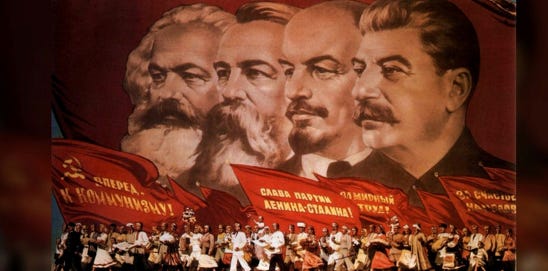
Mikhail Sergeyevich Gorbachev was the last leader of the Soviet Union from 1985 to the country’s dissolution in 1991. He served as General Secretary of the Communist Party of the Soviet Union from 1985 and additionally as head of state beginning in 1988, as Chairman of the Presidium of the Supreme Soviet from 1988 to 1989, Chairman of the Supreme Soviet from 1989 to 1990 and the only President of the Soviet Union from 1990 to 1991.
After The Wall collapsed, the US President at the time, George H.W. Bush, met with Gorbachev in Malta in early December 1989. They laid the groundwork for finalising the START negotiations (Strategic Arms Reduction Talks) and completed the Treaty on Conventional Armed Forces in Europe (CFE).
Malta was a historic turning point. They also discussed the rapid changes that were occurring in Eastern Europe. Bush encouraged Gorbachev’s reform efforts, hoping that the Soviet leader would succeed in shifting the USSR toward a democratic system and a market-oriented economy.
Gorbachev’s decision to allow elections with a multi-party system and create a presidency for the Soviet Union began a slow process of democratisation that eventually destabilised Communist control and contributed to the collapse of the communist Soviet Union.
Bush and Gorbachev signed the START treaty at the Moscow Summit in July 1991. Following a great deal of internal disruption, including a failed coup launched by hard-line communists, Gorbachev resigned as President of the Soviet Union on Christmas Day 1991.
On that day, December 25th, 1991, the Soviet Hammer and Sickle flag was lowered for the last time over the Kremlin, thereafter replaced by the Tricolour flag of the Russian Federation.
Boris Yeltsin became President of the newly independent Russian state. People all over the world watched in amazement as the former Communist monolithic empire of the USSR was transformed into multiple separate, independent, democratic nations. This relatively peaceful transition averted global warfare and allowed the people in those nations to discover their destiny.
RUSSIA IS NOT A COMMUNIST NATION. Russia is not the USSR. It is not a communist nation. It has an effective, independent central bank owned by the government and an effective system of privately owned commercial banks. It is also a nation focussed on productivity. It has enormous resources. And it has a system of private property. Russia and China have now developed a strong bond of mutual cooperation.
MORE MISTAKES — BANKING IN THE USSR DURING THE COMMUNIST ERA. Following the Russian Revolution in 1917, all of the banks’ assets were nationalised and liabilities cancelled (in late 1917). Banking was declared a State monopoly. From January 1920 to October 1921, there were no banks at all in operation in Russia. After that period of great turmoil, a banking system gradually took shape where there was a distinction made between bank money and money in the real economy.
Control of the money system was always strictly centralised and private bank ownership remained banned. The Soviet banking system relied on several specialised financial institutions which were reorganised in waves of reform following major leadership transitions in 1928-32, 1955-59, and 1987-88:
- The State Bank of the USSR (Gosbank), was established in October 1921 as the State Bank of the Russian Soviet Socialist Republic. Its scope was expanded to the whole of the Soviet Union in 1923.
- The State Labour Savings Banks System (Gostrudsberkassy), evolved from the savings banks of the previous Russian Imperial Empire and became a monopoly retail banking system. In 1963, the savings bank system was transferred under the jurisdiction of the Gosbank. It was reorganised in 1987 as the Savings Bank of the USSR.
- The Industrial Bank (Prombank) was established in 1922. In 1959 it became the All-Union Bank for Financing Capital Investments (Stroybank). In 1988, it was reorganised as the State Commercial Industrial and Construction Bank of the USSR (Promstroybank), with some operations spun off as Agro-Industrial Bank (Agroprombank) and the Bank of Housing, Communal Services and Social Development (Zhilsotsbank).
- The cooperative banking system, established in 1922 as the Bank of Consumer Cooperatives (Pokobank), was reorganised in 1923 as the All-Russian Cooperative Bank (Vsekobank), then replaced in 1936 with the All-Union Bank for Financing the Capital Construction of Trade and Cooperation (Torgbank) and eventually abolished in 1956. It was a decisive, historic moment that was the end of consumer cooperative banking in the USSR.
- The Central Bank of Public Utilities and Housing Construction (Tsekombank) was established in 1925 and terminated in 1959 with its operations allocated to the Gosbank and Stroybank. Another decisive moment — the end of separate financial management for housing construction, presumably deemed unnecessary as there was no ownership of private property.
- The Agricultural Bank of the USSR (Selkhozbank), established in 1932, terminated in 1959 with its operations allocated to the Gosbank and Stroybank. Yet another decisive moment — the end of geographically distributed banking services for the agricultural sector.
- The Foreign Trade Bank of the USSR was established in 1922 as Roskombank. In 1988 it was reorganised as the Bank for Foreign Economic Affairs of the USSR (Vnesheconombank).
This history reveals the mistakes made in the USSR’s banking sector and its impact on the industrial sector, housing sector, and agricultural sector. Those mistakes in rigidly centralised financial management and control led, inevitably, to declining productivity in the real economy. Without privately owned, geographically distributed commercial banks, without sustained productivity improvements, and privately owned housing, the economy was doomed.
CHINA HAS NOT MADE THOSE MISTAKES. China has learned from those mistakes and has adopted a very different structure of “communism”. Their economy is already the largest economy on Earth on a PPP basis. GDP (PPP) means gross domestic product based on purchasing power parity.
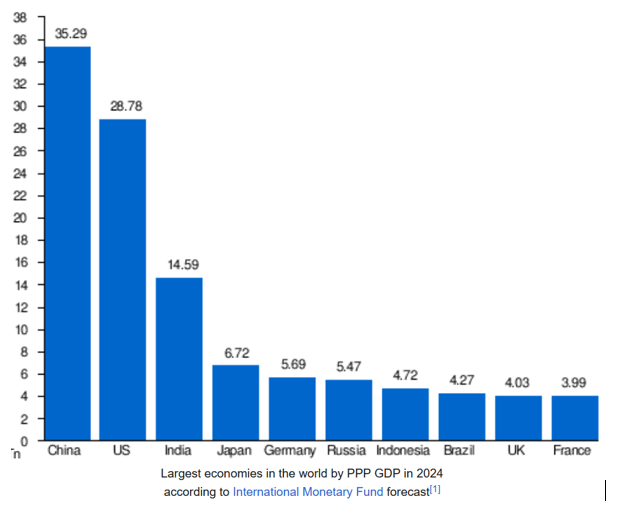
BOOM’s QUANTITATIVE BOOSTING FOR THE PEOPLES MONEY EXPLAINED: https://boomfinanceandeconomics.wordpress.com/2019/12/15/boom-as-at-15th-december-2019/ AND BOOM’s Perfect Economy: https://boomfinanceandeconomics.wordpress.com/2020/01/18/boom-as-at-19th-january-2020/
COMING NEXT:
- The Financial Jigsaw Part 2 – CHINA versus USA – Saturday, June 8, 2024
- BOOM Global Weekly Review – Tuesday, June 11, 2024
- Letter from South Africa – ELECTION SPECIAL – Saturday, June 15, 2024
In economics, things work until they don’t. Make your conclusions and do research. BOOM does not offer investment advice.
CLICK HERE FOR PODCASTS: OUR BRAVE NEW ECONOMIC WORLD
BANKS DON’T TAKE DEPOSITS, THEY BORROW YOUR MONEY: LOANS CREATE DEPOSITS — this is how almost all new money is created in the economy (by commercial banks making loans). https://www.bankofengland.co.uk/quarterly-bulletin/2014/q1/money-creation-in-the-modern-economy. Watch the short 15-minute video and see Professor Richard Werner brilliantly explaining how global banking systems work.
In 2014, Richard Werner provided the first empirical evidence that banks create credit out of thin air. They do this whenever they issue a loan or, more specifically, purchase a promissory note. This is a walk-through of exactly how they do it.
Many economists are unaware of this and even ignore the banking & finance sectors in their econometric models.
DISCLAIMER: All content is presented for educational and/or entertainment purposes only. Under no circumstances should it be mistaken for professional investment advice, nor is it at all intended to be taken as such. The commentary and other contents simply reflect the opinion of the authors alone on the current and future status of the markets and various economies. It is subject to error and change without notice. The presence of a link to a website does not indicate approval or endorsement of that website or any services, products, or opinions that may be offered by them.
Neither the information nor any opinion expressed constitutes a solicitation to buy or sell any neither securities or investments. Do NOT ever purchase any security or investment without doing your own and sufficient research. Neither BOOM Finance and Economics.com nor any of its principals or contributors are under any obligation to update or keep current the information contained herein. The principals and related parties may at times have positions in the securities or investments referred to and may make purchases or sales of these securities and investments while this site is live. The analysis contained is based on both technical and fundamental research.
Although the information contained is derived from sources that are believed to be reliable, they cannot be guaranteed.
Disclosure: We accept no advertising or compensation, and have no material connection to any products, brands, topics or companies mentioned anywhere on the site.
Fair Use Notice: This site contains copyrighted material the use of which has not always been specifically authorized by the copyright owner. We are making such material available in our efforts to advance understanding of issues of economic and social significance. We believe this constitutes a ‘fair use’ of any such copyrighted material as provided for in section 107 of the US Copyright Law. By Title 17 U.S.C. Section 107, the material on this site is distributed without profit. If you wish to use copyrighted material from this site for purposes of your own that go beyond ‘fair use’, you must obtain permission from the copyright owner.
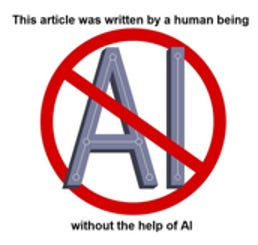







Can you talk about the ” new coalition” or lack of in South Africa as a result of the latest election ?
Yes Flash, it’s all in the melting pot at present. Under the SA constitution, a coalition must be formed within 14 days so my ‘Letter from South Africa’ due on June 15 will deal with the aftermath and likely events going forward.
In the meantime, it’s all speculation, but I can say that business favours an ANC/DA coalition.
Interesting times eh? but in the Western Cape, we have a DA ruling majority having increased their support this time – we are safe here.
So selling bonds to cover our out of control spending is not borrowing money???
and there won’t be any repercussions if we don’t repay what was borrowed, or repay it with money that has hyperinflated??? Sure….
You need to get up to speed on bond issuance, pyrrhus: https://www.investopedia.com/financial-edge/0312/the-basics-of-bonds.aspx
Bonds do not create new money…
I’m pretty sure there is quite a bit I (we?) do not understand about USA debt. I mean, really, this dissertation was about as clear as mud when I read it. But what the hell is the all powerful “debt clock” — showing we’re in debt to the tune of $34.8tn — what is that attributed to? What about the $1tn debt service (interest?) we have to pay every 100 days? Are we to conclude that what we thought was out of control spending from people who hate America and want their beloved New World Order to take control isn’t really “real”? And they can keep on piling on more debt without worry?
I call B.S. on this one…
The Fed Minions practically own America, the MSM, and Congress so they have practically already collected their debt per se; what would they do to collect the rest? However, they intend to implement programmed FedCoins by Jul2025 (and banish all US Treasury money, all other cryptos, all silver & gold money, and all barter). Everything we own will be Tokenized (converted to FedCoins) and the sum added to our bank account; we will probably be assigned an Individual Identification Number (probably a QR code invisibly printed on our right hand or forehead) to buy or sell. That would make them not just Money Masters but our Absolute Masters. Then they will own all America and all the livestock.
You are right RP3, their plan is to own EVERYTHING: https://elizabethnickson.substack.com/p/wall-streets-planned-theft-of-americas?utm_source=post-email-title&publication_id=30495&post_id=145142915&utm_campaign=email-post-title&isFreemail=true&r=hhrlz&triedRedirect=true&utm_medium=email
It’s a complex situation, RP3, and designed to confuse so the banksters can keep on shearing the sheep. This might help – the video on Repo is revealing:
https://austrianpeter.substack.com/p/a-perfect-storm-the-money-crisis?s=w